
Bathroom Design Tips
|
Cabinets In earlier days, "bathroom storage" meant a clunky medicine cabinet mounted above the pedestal or wallhung lavatory sink. Then along came boxy vanities, and the bathroom acquired a bank of drawers to one side of the plumbing compartment. As changing life-styles demand expression and bathrooms become grooming centers, exercise gyms, and spass, storage needs and configurations are also changing. One or more base cabinets may still form the backbone of the contemporary storage scheme, but bath storage areas have become more stylis, their design integrated with that of mirrors, sink, lighting, and backsplash treatments. Perhaps you'll wish to curve a custom unit around a corner, let built-ins form knee walls between use areas, or plan a floor-to-ceiling storage column. |
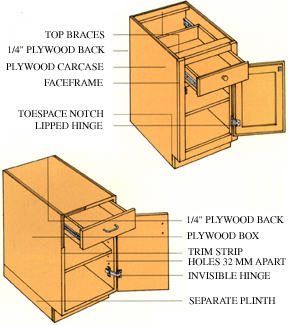 |
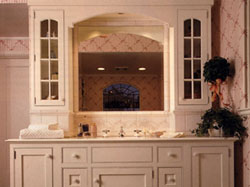
|
First, you'll need to choose between two basic cabinets mask the raw front edges of each box with a 1-by-2 "faceframe." Doors and drawers then fit in one of three ways: flush; partially offset, with a lip; or completely overlaying the frame. The outer edges of the faceframe can be planed and shaped (called "scribing") to fit the countours of an adjacent wall or ceiling. But the frame takes up space and reduces the size of the openings, so drawers or slide-out accessories must be significantly smaller than the full width of the cabinet. The terms "system 32" and "32-millimeter" refer to precise columns of holes drilled on the inside faces of many frameless cabinets. These holes are generally in the same place no matter what cabinets you buy, and interchangeable components such as shelf pins and pullout bins just fit right into them. |
|
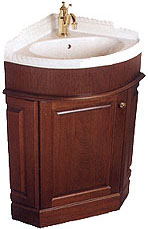 |
Bathroom cabinets are sporting new looks - and some old ones, too. The styles shown here include a furniture-like, frame-and-panel piece with built in valance lighting; a space-saving corner pedestal in traditional cherry; and a modern update of the tried-and-true medicine cabinet that includes strip lights and other amenities. | 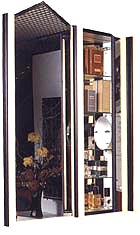 |
|
|
Stock Cabinets. Mass-produced, standard-size cabinets are the least expensive option, and they can be an excellent choice if you clearly understand what cabinetry you need. A recent development, the so-called RTA ("ready-to-assemble") cabinet, costs even less but requires basic tools and elbow grease to put together. An RTA vanity is shown on the facing page. As the name implies, the range of stock sizes limited. Even so, you can always specify door styles, direction of door swing, and finish of side panels.
Custom Cabinets. Many people still have a cabinetmaker come to their
house and measure, then return to the cabinet shop and build custom cabinet
boxes, drawers, and doors.
Custom shops can match old cabinets, size oddball configurations, and accommodate
complexities that can't be handled with stock or modular units. But such work
can cost considerably more than medium line stock or modular cabinets.
Modular Systems. Between stock and custom cabinetry are "custom modular cabinets" or "custom systems," which can sometimes offer the best of both worlds. They are manufactured, but they are of a higher grade and offer more design flexibility than stock cabinets. You can change virtually everything on these basic modules: add sliding shelves; replace doors with drawers; add wire bins, hampers, and pullouts. Dimensions can be changed also. Be advised, though: these cabinets could take a long time to show up at your doorstep.

What about dimensions?
The classic bathroom vanity measured about 32 inches high (with countertops)
by 21 inches deep and about 30 inches wide. But bath cabinets are growing -
new offerings may be up to 36 inches high by 24 inches deep and 48 inches wide.
You can make longer cabinet runs by joining units together.
Some bath cabinet lines include wall cabinets and tall storage units; otherwise,
look to kitchen cabinet manufacturers for ideas.
Judging Quality.
Within each line, costs are largely determined by the style of the doors and
drawers you choose. The simplest, least expensive option is often a flat or
"slab" door, popular for seamless European designs. Frame-and-panel designs
are more traditional and come in many versions, including raised panel (both
real and false), arched panel, beaded panel, and recessed or flat panel.
To determine the quality of a cabinet, first look closely at the drawers. They
take more of a beating than any other part of your cabinets. You'll pay a premium
for such features as solid-wood drawer boxes, sturdy dovetail joints, and full-extension,
ball-bearing guides.
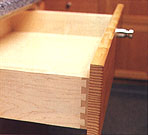
Are cabinet pulls included? If not, you'll pay more for them, but you'll be
able to choose exactly what you want. Door hinges are critical hardware elements.
European or "invisible" hinges are most trouble-free; consider these unless
you need the period look of surface hardware. Check for adjustability; hinges
should be able to be reset with the cabinets in place. Most cabinet boxes are
made from sheet products like plywood, particleboard (plain or laminated), or
medium-density fiberboard. Though solid lumber is sometimes used, it is usually
saved for doors and drawers. Hardwood plywood is surfaced with attractive wood
veneers on both face and back. The higher the face grade, the more you'll pay.
Particleboard costs less, weighs more, and is both weaker and more prone to
warping and moisture damage than plywood. Generally, particleboard vanitites
are faced with high-pressure plastic laminate or with a softer material called
melamine. Medium-density fiberboard (MDF), a denser, furniture-grade particleboard,
is available with high-quality hardwood veneers.
Countertops
Even after being steamed or splashed, good countertops still come up shining because they're moisture resistant - or better yet, waterproof. The best materials look great under stress and are less likely to scratch or chip.
What are your choices?
Plastic laminate, ceramic tile, solid-surface acrylics, and stone are the four major countertop materials in current use. Synthetic marble, while still common, isl osing some ground to solid-surface materials. Custom glass and cast concrete are gaining in popularity, especially in stylish master suites and powder rooms. Wood is sometimes useed for countertops, too; but to prevent water damage, the surface of wood countertops must be treated (perhaps repeatedly) with a durable finish.
Shopping around
When shopping, you probably won't be able to compare all the materials in one place. Some dealers with showrooms are listed in the yellow pages under Countertops or Kitchen Cabinets & Equipment; they'll probably have tile, plastic laminate, solid-surface products, and - maybe - wood. Large building-supply centers carry plastic laminate, synthetic marble, and wood. For other dealers or fabricators, check the categories Marble - Natural; Plastics; Class - Plate; Concrete Products; and Tile. Designers and architects can also supply samples.
Backsplash fever
These days, bathroom designers are using the backsplash - the wall surface surrounding the countertop proper - to make an aesthetic statement. A good backsplash also has practical advantages; if properly installed, it seals the area from moisture, and it makes the wall a lot easier to clean.
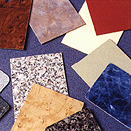 |
Plastic laminate Advantages. You can choose from a wide range of colors, textures, and patterns. Laminate is durable, easy to clean, water resistant and relatively inexpensive. Ready-made molded versions are called postformed; custom or self-rimmed countertops are built from scratch atop particleboard or plywood substrates. There are many laminates available for these tops, and edging options abound. With the right tools, you can install laminate yourself. |
Disadvantages.
It can scratch, chip, and stain, and it's hard to repair. Ready-made
postformed tops can look cheap, and other edgings may collect water
and grime. Conventional laminate has a dark backing that shows at
its seams; new solid-color laminates, designed to avoid this, are
somewhat brittle and more expensive. High-gloss laminates show every
smudge. |
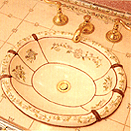 |
Ceramic tile Advantages. It's good-looking; comes in many colors, textures, and patterns; and is heat resistant and water resistant if installed correctly. Cost runs from inexpensive to pricey, depending on whether the tile is formed by machine or by hand and how many units are needed. Buy a tile that's rated for countertop use. Grout is also available in numerous colors. Patient do-it-yourselfers are likely to have good results. |
Disadvantages.
Some tile glazes can react adversely to acids or cleaning chemicals;
be sure to ask. Many people find it hard to keep grout satisfactorily
clean. Using epoxy grouts and thin, uniform grout lines can help The
hard, irregular surface can chip china and glassware. |
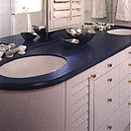 |
Solid-surface Advantages. Durable, water resistant, heat resistant, nonporous, and easy to clean, this marble-like material can be shaped and joined with virtually invisible seams. Different edge treatments are available. It allows for a variety of sink installations, including integral units that combine both basin and countertop. Blemishes and scratches can be sanded out. |
Disadvantages.
It's expensive, requiring professional fabrication and installation
for best results. It needs very firm support below. Until recently,
color selection was limited to white, beige, and almond; now stone
patterns and pastels are common. costs climb quickly for wood inlays
and other fancy edge details. |
 |
Stone Advantages. Granite, marble, and limestone, all popular for countertops, are beautiful natural materials. In most areas, you'll find a great selection of colors and figures. Stone is water resistant, heatproof, and very durable. Surface finishes range from polished to honed (matte) and even rougher textures. A number of thicknesses are available, and edges can be shaped in numerous ways. |
Disadvantages.
Oil, alcohol, and any acid (even chemicals in some water supplies)
can stain marble or limestone and damage its finish; granite can stand
up to all of these. Solid slabl are very expensive. Some designers
suggest stone tiles - including slate - as less expensive choices.
When shopping, take time to study the latest sealer options. |
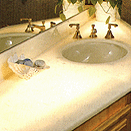 |
Synthetic marble Advantages. This group of man-made products, collectively known as "cast plymers," includes cultured marble, cultured onyx, and cultured granite. All three are relatively easy to clean. Cultured onyx is more translucent than cultured marble. These products are often sold with an integral sink. Prices range from inexpensive to moderate. you can color-coordinate a synthetic marble top with tub, shower, and wall panels. |
Disadvantages.
Sythetic marble is not very durable, and scratches and dings are hard
to mend (the surface finish is usually only a thin veneer). Backings,
typically, are porous. Quality varies widely; look for Cultured Marble
Institute or IAPMO certification. |
Flooring
The primary requirements for a bathroom floor are moisture resistance
and durability. Resilient tiles and sheets, ceramic tile, and properly
sealed masonry or hardwood are all good candidates. Resilient flooring
is the simplest (and usually the least expensive) to install; the others
are a little trickier. For a touch of comfort, don't rule out carpeting,
especially the newer stain-resistant industrial versions.
Planning checkpoints
Confused by the array of flooring types available? For help, study the
guide below. It's a good idea to visit flooring suppliers and home centers.
Most dealers are happy to give or lend samples to study.
For safety's sake, a bathroom floor must be slip resistant,
especially in wet areas. Tiles, either ceramic or resilient, are safest
in matte-finish or textured versions. Smaller ceramic tiles, with the
increased number of grout surfaces they require, offer extra traction.
A rubberized mat or throw rug (if if will stay put) can provide firm footing
- and a warm landing zone - near the tub or shower.
Don't be afraid to mix and match flooring materials.
Today's layouts often use different materials in the wet and dry areas
of the bath. Cozy carpeting is showing up in dressing areas, grooming
centers, and even exercise rooms. Hardwood strips or planks can play a
similar role in period or country design.
If you're on a tight budget, save the honed marble or
fine ceramic tile for a focal point, such as around a platform tub or
walk-in shower.
What about subflooring?
Don't make any final decision until you know what kind of subfloor your
new flooring will require.
With proper preparation, a concrete slab can serve as
a base for almost any type of flooring. Wood subfloors are not suitable
for rigid materials such as masonry and ceramic tile unless they are built
up with extras underlayment or floor framing. But adding too many layers
underneath can make the bathroom awkwardly higher than surrounding rooms.
Be sure to check with a building professional or a flooring dealer for
specifies.
| Resilient Advantages. Generally made from solid vinyl or polyurethane, resilients are flexible, moisture and stain resistant, easy to install, and simple to maintain. Another advantage is the seemingly endless variety of colors, textures, patterns, and styles available. Tiles can be mixed to form custom patterns or provide color accents. Sheets run up to 12 feet wide, eliminating the need for seaming in many bathrooms; tiles are generally 12 inches square. Vinyl and rubber are comfortable to walk |
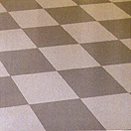 |
on. A plyurethane finish may eliminate the need
for waxing. Prices are generally modest, but expect to pay a premium
for custom tiles and imnported products. Disadvantages. Resilients are relatively soft, making them vulnerable to dents and tears; often, though, such damage can be repaired. Tiles may collect moisture between seams if improperly installed. Some vinyl still comes with a photographically applied pattern, but most is inlaid; the latter is more expensive but wears much better. |
| Ceramic tile Advantages. Made from hard-fired slabs of clay, ceramic tile is available in hundreds of patterns, colors, shapes, and finishes. Its durability, easy upkeep, and attractiveness are definite advantages. Tiles are usually classified as quarry tiles, commonly unglazed (unfinished) red-clay tiles that are rough and water resistant; terracotta, unglazed tiles in earth-tone shades; porcelain pavers, rugged tiles in stonelike shades and textures; and glazed floor tiles, available in glossy, matte, or textured finishes. |
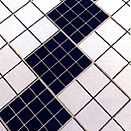 |
Floor tiles run the gamut of widths,
lengths, and thicknesses - 8-inch and 12-inch squares are most plentiful.
Costs range from inexpensive to moderate; in general, porcelain
is most expensive. Purer clays fired at higher temperature generally
make costlier but better-wearing tiles. Disadvantages. Tile can be cold, noisy, and, if glazed, slippery underfoot. Porous tiles will stain and harbor bacteria unless properly sealed. Grout spaces can be tough to keep clean, though mildew-resistant or epoxy grout definitely helps. |
| Hardwood Advantages. A classic hardwood floor creates a warm decor, feels good underfoot, and can be refinished. Oak is most common, with maple, birch, and other species also available. The three basic types are narrow strips in randow lengths; planks in various widths and random lenghts; and wood tiles, laid in blocks or squares. Wood flooring may be factory-prefinished or unfinished, to be sanded and finished in place. "Floating" floor systems have several veneered strips |
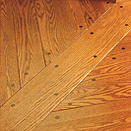 |
atop each backing board. In addition, you'll now
find "planks" and "tiles" of high-pressure laminate that look surprisingly
like the real thing. Disadvantages. Moisture damage and inadequate floor substructure are two bugaboos. Maintenance is another issue; some surfaces can be mopped or waxed, som cannot. Bleaching and some staining processes may wear unevenly and are difficult to repair. Cost is moderate to high, depending on wood species, grade, and finish. |
| Stone Advantages. Natural stone (such as slate, marble, granite, and limestone) has been used as flooring for centuries. Today, its use is even more practical, thanks to the development of efficient sealers and surfacing techniques. Stone can be used in its natural shape - known as flagstone - or cut into rectangular blocks or tiles. Generally, pieces are butted tightly together; irregular flagstones require wider grout joints. |
 |
Disadvantages. The cost of masonry flooring can be quite high, though recent diamond-saw technology has lowered it considerably. Moreover, the weight of the materials requires a very strong, well-supported subfloor. Some stone is cold and slippery underfoot, though new honed and etched surfaces are safer, subtler alternatives to polished surfaces. Certain stones, such as marble and limestone, absorb stains and dirt readily. Careful sealing is essential. |
| Carpeting Advantages. Carpeting cushions feet, provides firm traction, and helps deaden sound. It's especially useful to define subareas within multiuse layouts or master suites. New tightly woven commercial products are making carpeting more practical. Like resilient flooring, carpeting is available in an array of styles and materials, with prices that vary widely. |
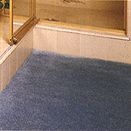 |
Disadvantages. Generally, the more elaborate the material and weave, the greater the problems from moisture absorption, staining, and mildew. Carpeting used in bathrooms should be short-pile and unsculptured. Woven or loop-pile wool should be confined to dressing areas. Nylon and other sythetic carpets are a wiser choice for splash zones; these are washable and hold up better in moist conditions. |
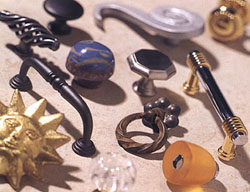 Stock, custom, or modular?
Stock, custom, or modular?













